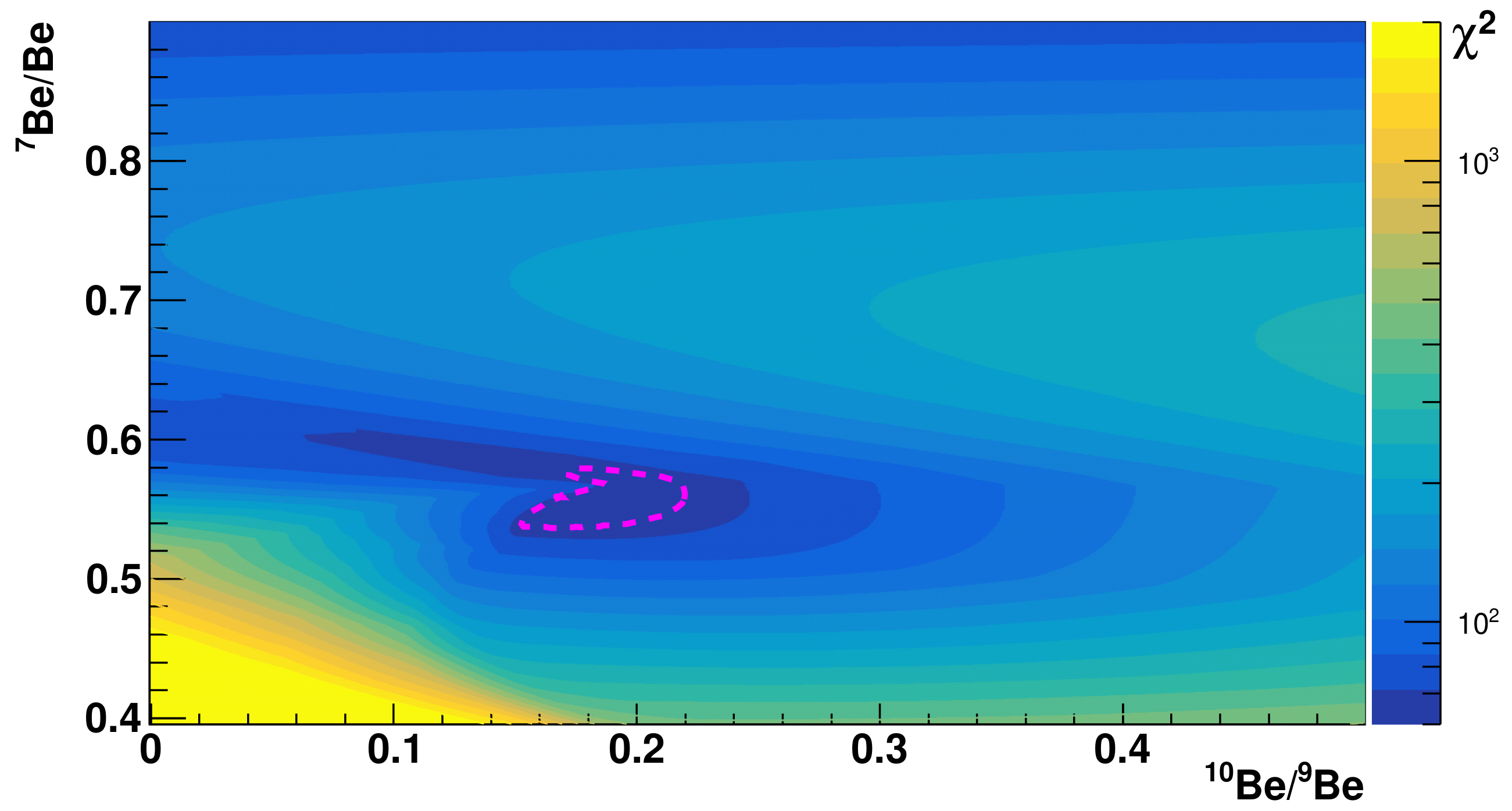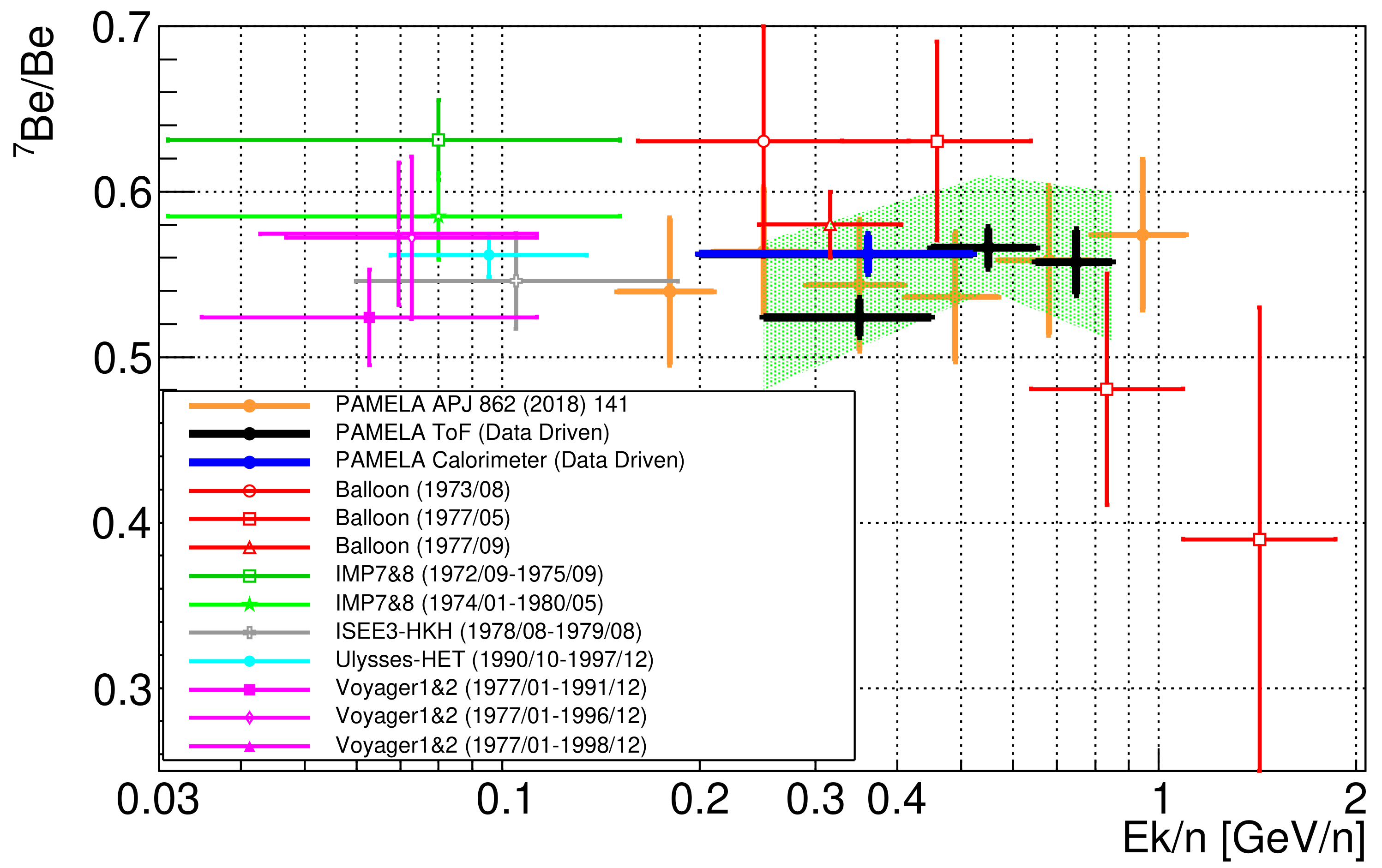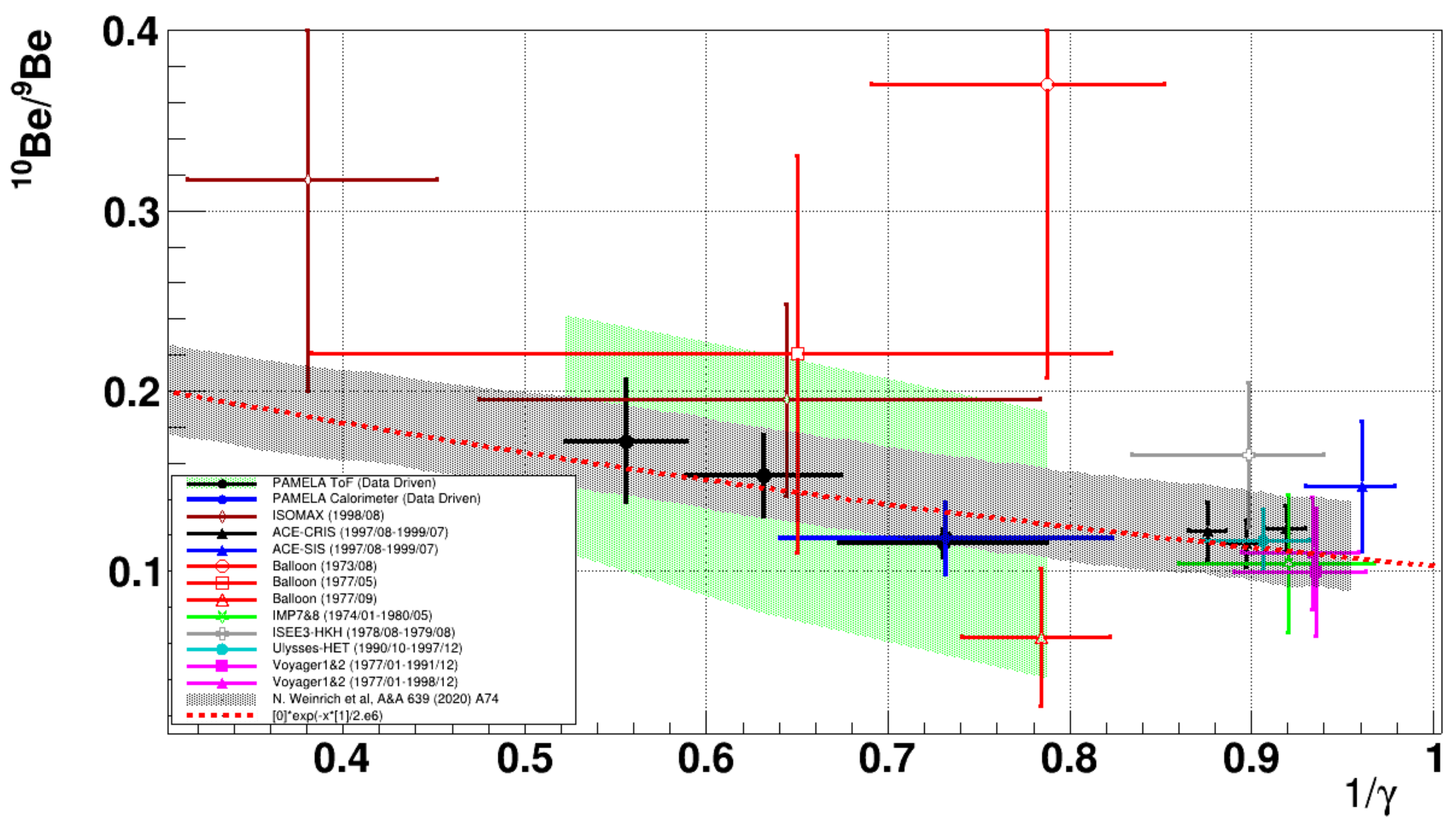Beryllium Radioactive Isotopes as a Probe to Measure the Residence Time of Cosmic Rays in the Galaxy and Halo Thickness: A “Data-Driven” Approach †
Abstract
1. Introduction
Beryllium Isotopic Measurements in Cosmic Rays
- Be: stable bare nucleus. It decays by electron capture (T = 53 days).
- Be: stable.
- Be -radioactive nucleus (T = 1.39 years).
2. Data-Driven Analysis
2.1. Template Transformations
2.2. Data-Driven Template Evaluation
3. An Example of an Application to Pamela Lithium and Beryllium Events
4. Results and Discussion
Author Contributions
Funding
Institutional Review Board Statement
Informed Consent Statement
Conflicts of Interest
References
- Evoli, C.; Morlino, G.; Blasi, P.; Aloisio, R. AMS-02 beryllium data and its implication for cosmic ray transport. Phys. Rev. D 2020, 101, 023013. [Google Scholar] [CrossRef]
- Feng, J.; Tomassetti, N.; Oliva, A. Bayesian analysis of spatial-dependent cosmic-ray propagation: Astrophysical background of antiprotons and positrons. Phys. Rev. D 2016, 94, 123007. [Google Scholar] [CrossRef]
- Korsmeier, M.; Cuoco, A. Galactic cosmic-ray propagation in the light of AMS-02: Analysis of protons, helium, and antiprotons. Phys. Rev. D 2016, 94, 123019. [Google Scholar] [CrossRef]
- Weinrich, N.; Boudaud, M.; Derome, L.; Génolini, Y.; Lavalle, J.; Maurin, D.; Salati, P.; Serpico, P.; Weymann-Despres, G. Galactic halo size in the light of recent AMS-02 data. Astron. Astrophys. 2020, 639, A74. [Google Scholar] [CrossRef]
- Luque, P.D.L.T.; Mazziotta, M.; Loparco, F.; Gargano, F.; Serini, D. Implications of current nuclear cross sections on secondary cosmic rays with the upcoming DRAGON2 code. J. Cosmol. Astropart. Phys. 2021, 2021, 099. [Google Scholar] [CrossRef]
- Webber, W.R.; Soutoul, A. A Study of the Surviving Fraction of the Cosmic-Ray Radioactive Decay Isotopes 10Be,26Al,36Cl and 54Mn as a Function of Energy Using the Charge Ratios Be/B, Al/Mg, Cl/Ar, and Mn/Fe Measured on HEAO 3. Astrophys. J. 1998, 506, 335–340. [Google Scholar] [CrossRef]
- Tomassetti, N. Examination of uncertainties in nuclear data for cosmic ray physics with the AMS experiment. Phys. Rev. C 2015, 92, 045808. [Google Scholar] [CrossRef]
- Tomassetti, N. Solar and nuclear physics uncertainties in cosmic-ray propagation. Phys. Rev. D 2017, 96, 103005. [Google Scholar] [CrossRef]
- Menn, W.; Bogomolov, E.A.; Simon, M.; Vasilyev, G.; Adriani, O.; Barbarino, G.C.; Bazilevskaya, G.A.; Bellotti, R.; Boezio, M.; Bongi, M.; et al. Lithium and Beryllium Isotopes with the PAMELA Experiment. Astrophys. J. 2018, 862, 141. [Google Scholar] [CrossRef]
- Aguilar, M.; Cavasonza, L.A.; Ambrosi, G.; Arruda, L.; Attig, N.; Bachlechner, A.; Plyaskin, V. Properties of Cosmic Helium Isotopes Measured by the Alpha Magnetic Spectrometer. Phys. Rev. Lett. 2019, 123, 181102. [Google Scholar] [CrossRef]
- Efron, B. Better Bootstrap Confidence Intervals. J. Am. Stat. Assoc. 1987, 82, 171–185. [Google Scholar] [CrossRef]
- Yanasak, N.E.; Wiedenbeck, M.E.; Mewaldt, R.A.; Davis, A.J.; Cummings, A.C.; George, J.S.; Leske, R.A.; Stone, E.C.; Christian, E.R.; von Rosenvinge, T.T.; et al. Measurement of the Secondary Radionuclides 10Be, 26Al, 36Cl, 54Mn, and 14C and Implications for the Galactic Cosmic-Ray Age. Astrophys. J. 2001, 563, 768–792. [Google Scholar] [CrossRef]
- Hagen, F.A.; Fisher, A.J.; Ormes, J.F. Be-10 abundance and the age of cosmic rays—A balloon measurement. Astrophys. J. 1977, 212, 262–277. [Google Scholar] [CrossRef]
- Buffington, A.; Orth, C.D.; Mast, T.S. A measurement of cosmic-ray beryllium isotopes from 200 to 1500 MeV per nucleon. Astrophys. J. 1978, 226, 355–371. [Google Scholar] [CrossRef]
- Webber, W.R.; Kish, J. Further Studies of the Isotopic Composition of Cosmic Ray Li, Be and B Nuclei—Implications for the Cosmic Ray Age; ICRC: Kyoto, Japan, 1979; Volume 1, p. 389. [Google Scholar]
- Garcia-Munoz, M.; Mason, G.M.; Simpson, J.A. The age of the galactic cosmic rays derived from the abundance of Be-10. Astrophys. J. 1977, 217, 859–877. [Google Scholar] [CrossRef]
- Garcia-Munoz, M.; Simpson, J.A.; Wefel, J.P. The Propagation Lifetime of Galactic Cosmic Rays Determined from the Measurement of the Beryllium Isotopes; ICRC: Paris, France, 1981; Volume 2, pp. 72–75. [Google Scholar]
- Wiedenbeck, M.E.; Greiner, D.E. A cosmic-ray age based on the abundance of Be-10. Astrophys. J. 1980, 239, L139–L142. [Google Scholar] [CrossRef]
- Hams, T.; Barbier, L.M.; Bremerich, M.; Christian, E.R.; de Nolfo, G.A.; Geier, S.; Göbel, H.; Gupta, S.K.; Hof, M.; Menn, W.; et al. Measurement of the Abundance of Radioactive 10Be and Other Light Isotopes in Cosmic Radiation up to 2 GeV Nucleon−1 with the Balloon-borne Instrument ISOMAX. Astrophys. J. 2004, 611, 892–905. [Google Scholar] [CrossRef]
- Connell, J.J. Galactic Cosmic-Ray Confinement Time: ULYSSES High Energy Telescope Measurements of the Secondary Radionuclide 10Be. Astrophys. J. 1998, 501, L59. [Google Scholar] [CrossRef]
- Lukasiak, A.; Ferrando, P.; McDonald, F.B.; Webber, W.R. The isotopic composition of cosmic-ray beryllium and its implication for the cosmic ray’s age. Astrophys. J. 1994, 423, 426–431. [Google Scholar] [CrossRef]
- Lukasiak, A.; McDonald, F.B.; Webber, W.R. Voyager Measurements of the Isotopic Composition of Li, Be and B Nuclei; ICRC: Durban, South Africa, 1997; Volume 3, p. 389. [Google Scholar]
- Lukasiak, A. Voyager Measurements of the Charge and Isotopic Composition of Cosmic Ray Li, Be and B Nuclei and Implications for Their Production in the Galaxy; ICRC: Salt Lake City, UT, USA, 1999; Volume 3, p. 41. [Google Scholar]
- Aguilar, M.; Alcaraz, J.; Allaby, J.; Alpat, B.; Ambrosi, G.; Anderhub, H.; Ao, L.; Arefiev, A.; Arruda, L.; Azzarello, P.; et al. Isotopic composition of light nuclei in cosmic rays: Results from AMS-01. Astrophys. J. 2011, 736, 105. [Google Scholar] [CrossRef]
- Straulino, S.; Adriani, O.; Bonechi, L.; Bongi, M.; Castellini, G.; D’Alessandro, R.; Gabbanini, A.; Grandi, M.; Papini, P.; Ricciarini, S.; et al. The PAMELA silicon tracker. Nucl. Instrum. Methods Phys. Res. Sect. Accel. Spectrometers Detect. Assoc. Equip. 2004, 530, 168–172. [Google Scholar] [CrossRef]
- Donato, F.; Maurin, D.; Taillet, R. Radioactive cosmic rays in a diffusion model: Test for a local bubble? Astron. Astrophys. 2002, 381, 539–559. [Google Scholar] [CrossRef][Green Version]









| E/n [GeV/n] | Li/Li | |
|---|---|---|
| 0.15–0.35 (Calo) | 0.95 ± 0.03 ± 0.2 | |
| 0.35–0.75 (Calo) | 0.94 ± 0.03 ± 0.25 | |
| 0.15–0.35 (ToF) | 0.96 ± 0.03 ± 0.2 | |
| 0.35–0.75 (ToF) | 0.88 ± 0.04 ± 0.25 | |
| E/n [GeV/n] | Be/Be | Be/Be |
| 0.2–0.52 (Calo) | 0.56 ± 0.01 ± 0.03 | 0.12 ± 0.02 ± 0.07 |
| 0.25–0.45 (ToF) | 0.53 ± 0.01 ± 0.03 | 0.115 ± 0.01 ± 0.07 |
| 0.45–0.65 (ToF) | 0.56 ± 0.01 ± 0.035 | 0.15 ± 0.02 ± 0.07 |
| 0.65–0.85 (ToF) | 0.56 ± 0.02 ± 0.04 | 0.17 ± 0.03 ± 0.07 |
Publisher’s Note: MDPI stays neutral with regard to jurisdictional claims in published maps and institutional affiliations. |
© 2021 by the authors. Licensee MDPI, Basel, Switzerland. This article is an open access article distributed under the terms and conditions of the Creative Commons Attribution (CC BY) license (https://creativecommons.org/licenses/by/4.0/).
Share and Cite
Nozzoli, F.; Cernetti, C. Beryllium Radioactive Isotopes as a Probe to Measure the Residence Time of Cosmic Rays in the Galaxy and Halo Thickness: A “Data-Driven” Approach. Universe 2021, 7, 183. https://doi.org/10.3390/universe7060183
Nozzoli F, Cernetti C. Beryllium Radioactive Isotopes as a Probe to Measure the Residence Time of Cosmic Rays in the Galaxy and Halo Thickness: A “Data-Driven” Approach. Universe. 2021; 7(6):183. https://doi.org/10.3390/universe7060183
Chicago/Turabian StyleNozzoli, Francesco, and Cinzia Cernetti. 2021. "Beryllium Radioactive Isotopes as a Probe to Measure the Residence Time of Cosmic Rays in the Galaxy and Halo Thickness: A “Data-Driven” Approach" Universe 7, no. 6: 183. https://doi.org/10.3390/universe7060183
APA StyleNozzoli, F., & Cernetti, C. (2021). Beryllium Radioactive Isotopes as a Probe to Measure the Residence Time of Cosmic Rays in the Galaxy and Halo Thickness: A “Data-Driven” Approach. Universe, 7(6), 183. https://doi.org/10.3390/universe7060183







